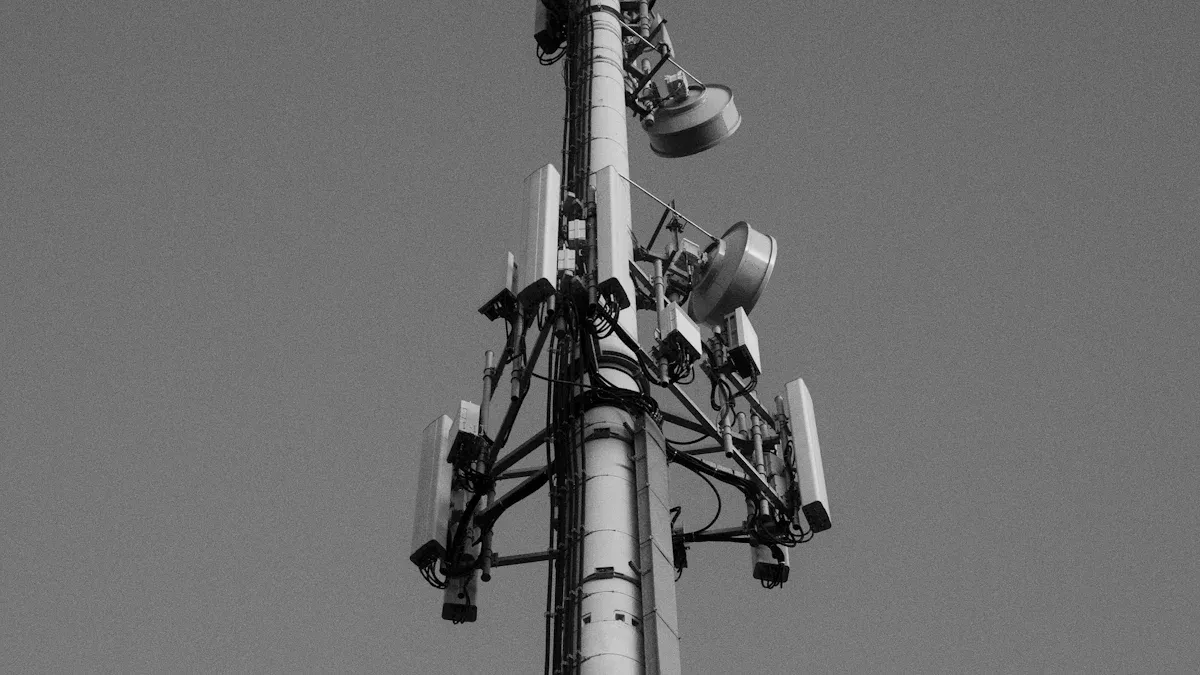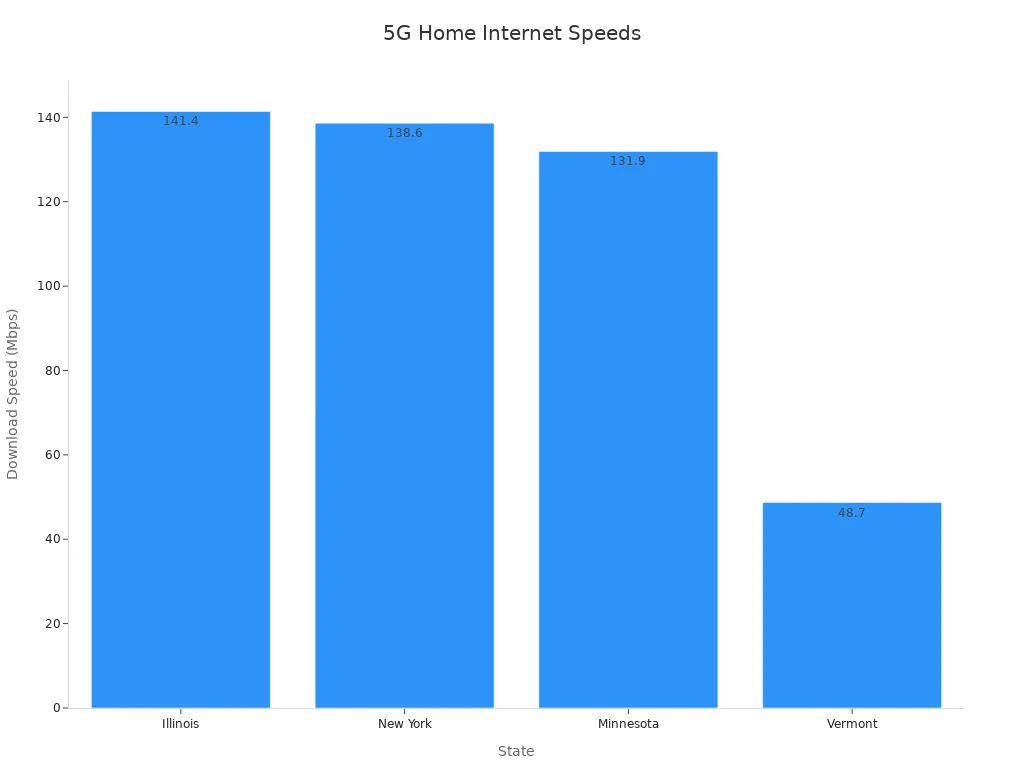
A 5G modem router is a device that connects your home or office to the internet using the latest 5G cellular network technology. Unlike traditional broadband, it doesn’t rely on physical cables. Instead, it uses wireless signals from nearby 5G towers to deliver internet access.
The way it works is simple. The modem inside the router receives 5G signals, processes them, and turns them into usable internet data. The router then distributes this data to your devices through Wi-Fi or Ethernet connections. With speeds up to 100 times faster than 4G, 5G modem routers are transforming how people access high-speed internet globally. The market for these devices is growing rapidly, projected to reach $28.3 billion by 2032, driven by the demand for faster connections and smart home integration.
The 5G Fixed Wireless Access Global Market Report 2025 highlights the rapid adoption of 5G technology, emphasizing its role in revolutionizing internet access worldwide.
Understanding 5G Modem Routers
What makes 5G technology unique?
5G technology stands out because of its incredible speed, low latency, and ability to handle a massive number of devices simultaneously. Unlike older networks, 5G delivers speeds up to 10 Gbps, which is 100 times faster than 4G. This means you can download large files, stream 4K videos, or play online games without interruptions. The latency, or the delay in data transfer, is as low as 1 millisecond, making it almost imperceptible. This is crucial for applications like autonomous vehicles and real-time gaming, where even a slight delay can cause issues.
Another unique feature of 5G is its capacity to connect more devices at once. Whether you’re using smart home gadgets, IoT devices, or multiple smartphones, 5G ensures stable and reliable connections. This is especially important in today’s world, where homes and offices rely on dozens of connected devices. The combination of speed, low latency, and high capacity makes 5G technology a game-changer for internet connectivity.
| Feature | 5G Performance | 4G Performance |
|---|---|---|
| Average Speed | Up to 10 Gbps (100x faster than 4G) | Varies, generally slower |
| Latency | 1ms (imperceptible) | 20-50ms |
| Network Capacity | Supports more devices simultaneously | Limited by congestion |
| Stability | 500x connection density | Prone to congestion |
How 5G modem routers connect to 5G networks
A 5G modem router connects to 5G networks by receiving wireless signals from nearby 5G towers. The modem inside the device processes these signals and converts them into internet data. This data is then distributed to your devices through Wi-Fi or Ethernet connections. Unlike traditional broadband, which relies on cables, 5G modem routers use the 5G cellular network to provide internet access. This makes them highly portable and easy to set up.
The performance of a 5G modem depends not only on its hardware but also on its software. Advanced 5G wireless routers can intelligently manage traffic, ensuring optimal performance even when multiple devices are connected. This is especially useful for activities like streaming, gaming, or video conferencing, where seamless connectivity is essential.
Wi-Fi distribution through 5G modem routers
Once a 5G modem router receives a 5G signal, it distributes the internet to your devices using Wi-Fi. Modern 5G wireless routers support the latest Wi-Fi standards, such as Wi-Fi 6 and Wi-Fi 6E, which offer faster speeds and better coverage. These routers can handle multiple devices at once without compromising performance, making them ideal for homes, offices, and even public spaces.
For example, if you’re using 5G home internet, your router can provide strong and stable Wi-Fi signals throughout your house. This ensures that every device, from your smartphone to your smart TV, gets a reliable connection. Additionally, 5G Wi-Fi routers often come with advanced features like beamforming, which focuses the Wi-Fi signal toward your devices for better performance. This makes 5G home internet a practical and efficient solution for modern connectivity needs.
Tip: To get the best performance from your 5G modem router, place it in a central location and ensure it has a clear line of sight to the 5G tower.
Benefits of 5G Home Internet

Speed and performance advantages
One of the most significant benefits of 5G home internet is its incredible speed and performance. With 5G, you can experience faster data speeds that surpass traditional broadband and 4G networks. The median global 5G download speed increased by 20% in 2023, reaching 203.04 Mbps, compared to 168.27 Mbps the previous year. In the United States, states like Illinois and New York report average 5G speeds of over 130 Mbps, showcasing the remarkable capabilities of this technology.
| State | Average 5G Download Speed (Mbps) |
|---|---|
| Illinois | 141.4 |
| New York | 138.6 |
| Minnesota | 131.9 |
| Vermont | 48.7 |

5G home internet plans offer speeds ranging from 50 Mbps to 1,000 Mbps, with peak download speeds reaching up to 20 Gbps. This means you can download large files, stream ultra-high-definition videos, and enjoy seamless online gaming without interruptions. Whether you’re working from home or managing multiple connected devices, 5G ensures a smooth and efficient experience.
Note: To maximize your internet speed, ensure your 5G modem router is placed in an optimal location with minimal obstructions.
Enhanced connectivity for IoT and smart homes
5G home internet is revolutionizing how smart homes and IoT devices operate. With its low latency and high capacity, 5G can handle the growing number of connected devices in modern households. The latency of 5G is less than 5 milliseconds, compared to 60 to 98 milliseconds for 4G. This near-instantaneous response time is crucial for devices like smart thermostats, security cameras, and voice assistants.
| Factors | 5G | 4G |
|---|---|---|
| Latency | Less than 5 ms | 60 to 98 ms |
| Potential Download Speed | 20 Gbps | 1 Gbps |
| Goal for Cell Density | 100 times greater than 4G | 200 to 400 users per cell |
With 5G home internet service, you can connect more devices simultaneously without experiencing network congestion. This is especially important for homes with multiple IoT devices, such as smart lights, refrigerators, and entertainment systems. The enhanced connectivity provided by 5G ensures that all your devices work seamlessly together, creating a truly smart and efficient living environment.
Tip: When choosing 5G home internet options, consider plans that support the latest Wi-Fi standards like Wi-Fi 6 or Wi-Fi 6E for optimal performance.
Portability and flexibility
Unlike traditional broadband, which relies on fixed cables, 5G home internet offers unmatched portability and flexibility. A 5G modem router connects to the 5G cellular network, allowing you to set up internet access anywhere with 5G coverage. This makes it an excellent choice for people who move frequently or live in areas where traditional broadband isn’t available.
For example, if you’re traveling or hosting an event, you can take your 5G modem with you and enjoy high-speed internet on the go. This flexibility also benefits rural areas, where laying cables for broadband can be challenging. With 5G home internet, you can access reliable and fast internet without the need for extensive infrastructure.
Callout: 5G cellular technology is transforming connectivity by making high-speed internet more accessible and adaptable to your lifestyle.
The portability of 5G home internet plans also makes them ideal for temporary setups, such as construction sites or pop-up events. You can enjoy the same level of performance and reliability as you would with a fixed broadband connection, but with the added convenience of mobility.
Comparing 5G Modem Routers to Other Technologies
5G cellular routers vs. 4G LTE routers
5G cellular routers offer significant improvements over 4G LTE routers in terms of speed, capacity, and overall performance. While 4G LTE routers have been reliable for years, they cannot match the capabilities of 5G cellular routers. For instance, the fastest LTE technology, LTE Cat 22, delivers a maximum download speed of 4 Gbps and an upload speed of 450 Mbps. In comparison, 5G cellular routers can achieve download speeds of up to 10 Gbps, making them more than twice as fast. This speed boost allows you to download large files, stream ultra-HD videos, and enjoy lag-free gaming.
| Technology | Max Download Speed | Max Upload Speed |
|---|---|---|
| LTE Cat 22 | 4 Gbps | 450 Mbps |
| 5G | Up to 10 Gbps | N/A |
| LTE (fastest) | 2.5 Gbps | N/A |
Additionally, 5G cellular routers support more devices simultaneously, making them ideal for homes with multiple users or IoT devices. They also offer lower latency, ensuring smoother performance for real-time applications like video calls and online gaming.
Differences from traditional broadband solutions
Unlike traditional broadband, which relies on physical cables like fiber or DSL, 5G modem routers use wireless 5G networks to deliver internet access. This eliminates the need for extensive infrastructure, making 5G home internet more accessible in areas where laying cables is impractical. You can set up a 5G cellular router quickly without waiting for technicians or dealing with installation delays.
Traditional broadband often struggles with network congestion during peak hours. In contrast, 5G router solutions handle high traffic more efficiently, ensuring consistent speeds. Moreover, 5G home internet offers portability. You can take your 5G modem to a new location and enjoy high-speed internet as long as there’s 5G coverage.
Advantages over satellite internet
5G cellular routers outperform satellite internet in several key areas. Satellite internet often suffers from high latency due to the long distance data must travel between Earth and satellites. This can result in delays of 600 milliseconds or more, making it unsuitable for activities like gaming or video conferencing. In contrast, 5G cellular routers offer latency as low as 1 millisecond, providing near-instantaneous responses.
Satellite internet speeds also vary depending on weather conditions and location. On the other hand, 5G home internet delivers consistent performance in most environments with 5G coverage. Additionally, 5G cellular routers are more cost-effective. Satellite internet often requires expensive equipment and installation, whereas 5G router solutions are more affordable and easier to set up.
Tip: If you’re considering switching to 5G home internet service, check the 5G coverage in your area to ensure optimal performance.
Use Cases for 5G Modem Routers in 2025

Remote work and education
In 2025, 5G modem routers are revolutionizing remote work and online education. They provide high-speed internet that ensures smooth video conferencing, quick file uploads, and uninterrupted access to cloud-based tools. With 5G home internet, you can work or study from anywhere with 5G coverage. This flexibility is especially beneficial for professionals and students who need reliable connectivity.
The demand for high-speed data continues to grow. The 5G system integration market is projected to rise from $15.53 billion in 2024 to $20 billion in 2025, reflecting a CAGR of 28.8%. This growth highlights the increasing reliance on 5G for remote work and education. Whether you’re attending virtual classes or collaborating with a global team, 5G modem routers make it possible to stay connected without delays.
Tip: To optimize your remote work or study experience, place your 5G modem router in a central location for better Wi-Fi coverage.
Gaming and streaming
For gamers and streamers, 5G home internet offers a game-changing experience. With speeds up to 10 Gbps and latency as low as 1 millisecond, you can enjoy lag-free gaming and buffer-free streaming. Whether you’re playing competitive online games or watching 4K UHD movies, 5G ensures a seamless experience.
The rising popularity of HD and UHD content has increased the need for high-speed bandwidth. 5G modem routers meet this demand by delivering consistent performance, even during peak hours. You can connect multiple devices without compromising speed, making it ideal for households with gamers and streamers.
Callout: 5G technology enhances your entertainment experience by providing ultra-fast and reliable internet for gaming and streaming.
Internet access in rural areas
5G modem routers are bridging the digital divide in rural areas. Traditional broadband often struggles to reach remote locations due to infrastructure challenges. In contrast, 5G home internet relies on wireless networks, making it easier to provide high-speed connectivity in underserved regions.
With 5G, rural communities can access the same level of internet performance as urban areas. This opens up opportunities for remote work, online education, and telemedicine. The portability of 5G modem routers also allows you to set up internet access quickly, without waiting for extensive installations.
Note: If you live in a rural area, check for 5G coverage to enjoy fast and reliable internet with a 5G modem router.
Temporary setups for events and travel.
Temporary setups often demand reliable and portable internet solutions. Whether you’re hosting an event, traveling for work, or setting up a pop-up shop, a 5G modem router offers unmatched convenience. Its ability to connect to 5G networks ensures high-speed internet access wherever coverage is available.
For events like conferences, trade shows, or outdoor festivals, a 5G modem router can handle the connectivity needs of multiple attendees. You can set up a temporary Wi-Fi network in minutes without relying on fixed broadband installations. This flexibility allows you to focus on the event itself rather than worrying about internet logistics. For example, a 5G router can support live streaming, ticket scanning, and vendor transactions simultaneously, ensuring a seamless experience for everyone involved.
When traveling, a 5G modem router becomes your portable internet hub. Whether you’re on a business trip or a family vacation, you can stay connected without relying on hotel Wi-Fi or public networks. This is especially useful for remote workers who need secure and fast internet access to attend virtual meetings or upload large files. The compact design of many 5G routers makes them easy to carry, fitting perfectly into your travel bag.
Pop-up shops and temporary retail setups also benefit from 5G technology. A 5G modem router enables you to process payments, manage inventory, and provide customer Wi-Fi without the need for permanent infrastructure. This adaptability makes it an essential tool for businesses that operate in dynamic environments.
Tip: Before using a 5G modem router for events or travel, check the 5G coverage in your area to ensure optimal performance.
Challenges and Considerations
Cost and affordability of 5G modem routers
The cost of 5G modem routers remains a significant consideration for many households. While 5G technology offers incredible benefits, its advanced features often come with a higher price tag. Innovations like dual-band and tri-band technologies increase the cost of production, which impacts the final price for consumers. Additionally, the growing demand for unlimited data plans to support online activities has driven up overall expenses.
Economic factors also play a role in affordability. Microeconomic trends, such as rising material costs, and macroeconomic influences, like inflation, affect pricing. The pandemic disrupted supply chains, leading to higher manufacturing costs. However, some companies are working to make 5G home internet more accessible. For example, partnerships like Straight Talk Home with Walmart aim to provide affordable options for consumers.
| Insight Type | Description |
|---|---|
| Technological Advancements | Innovations like dual-band and tri-band technologies impact pricing. |
| Market Dynamics | Increased demand for unlimited plans drives costs. |
| Economic Indicators | Micro and macroeconomic factors influence affordability. |
| Business Strategies | Partnerships aim to offer affordable 5G home internet options. |
| Impact of COVID-19 | Supply chain disruptions have affected pricing strategies. |
Availability of 5G coverage
The availability of 5G coverage varies widely across regions. Urban areas often enjoy extensive 5G networks, while rural and remote locations may still lack access. This disparity creates challenges for those who want to adopt 5G home internet but live in areas with limited coverage. Expanding 5G networks requires significant investment in infrastructure, including the installation of more 5G towers.
Governments and private companies are working to improve 5G home internet availability. Initiatives to expand coverage aim to bridge the digital divide, ensuring that more people can benefit from high-speed internet. However, achieving widespread availability takes time and resources. Before investing in a 5G modem router, you should check the 5G coverage in your area to ensure it meets your needs.
Network performance during peak usage
Network performance can fluctuate during peak usage times. When many users connect to the same 5G tower, the network may experience congestion. This can lead to slower speeds and reduced reliability, especially in densely populated areas. Although 5G networks are designed to handle more devices than previous technologies, they are not immune to these challenges.
To address this issue, many 5G providers are implementing advanced traffic management systems. These systems prioritize data flow, ensuring that essential activities like video calls and online gaming remain smooth. As a user, you can optimize your experience by placing your 5G modem router in an ideal location and limiting unnecessary device connections during peak hours.
Tip: Check your provider’s network performance reports to understand how well their 5G service handles peak usage in your area.
Security and privacy concerns.
As you embrace 5g technology, understanding its security and privacy implications becomes essential. The rapid speed and connectivity of 5g networks bring many benefits, but they also introduce new challenges. These challenges arise because 5g networks rely on a complex infrastructure that connects billions of devices globally.
One major concern is the increased risk of cyberattacks. With more devices connected to 5g networks, hackers have more opportunities to exploit vulnerabilities. For example, smart home devices like cameras and thermostats can become entry points for unauthorized access. You must ensure that your devices are updated with the latest security patches to reduce these risks.
Another issue involves data privacy. 5g networks process vast amounts of data at incredible speeds. This data often includes sensitive information, such as your location, browsing habits, and personal details. Without proper safeguards, this information could be intercepted or misused. Using strong passwords and enabling encryption on your 5g modem router can help protect your data.
The decentralized nature of 5g networks also poses challenges. Unlike older networks, 5g relies on many small cell towers instead of a few large ones. While this improves coverage, it also creates more points where data can be intercepted. You should always verify that your 5g service provider follows strict security protocols to protect your information.
Finally, the rise of Internet of Things (IoT) devices connected through 5g increases the risk of privacy breaches. Each device adds another layer of vulnerability. To stay safe, you should regularly review the security settings of your IoT devices and disconnect any that you no longer use.
Tip: Always use a trusted 5g modem router from a reputable manufacturer. This ensures that your device includes advanced security features to protect your network.
By staying informed and taking proactive steps, you can enjoy the benefits of 5g technology while minimizing security and privacy risks.
A 5G modem router offers unmatched speed, low latency, and the ability to connect multiple devices seamlessly. These features make it a powerful broadband alternative in 2025, especially for homes, businesses, and rural areas. The global 5G CPE market is projected to grow from $13.4 billion in 2024 to $41.5 billion by 2033, with a CAGR of 14.1%. This growth reflects the increasing demand for high-speed connectivity. With 75 billion IoT devices expected by 2025, 5G will continue to transform how you stay connected, paving the way for smarter homes and workplaces.
FAQ
What is the difference between a 5G modem and a 5G router?
A 5G modem connects to the 5G network and converts signals into internet data. A 5G router distributes this data to your devices via Wi-Fi or Ethernet. Many devices combine both functions into one unit, called a 5G modem router.
Can I use a 5G modem router if my area doesn’t have 5G coverage?
No, a 5G modem router requires 5G network coverage to function. However, some models support fallback to 4G LTE networks. Check your device specifications and local network availability before purchasing.
How do I set up a 5G modem router?
Setting up a 5G modem router is simple. Plug it into a power source, insert a SIM card (if required), and follow the setup instructions in the user manual. Place it in a central location for optimal signal strength.
Tip: Avoid placing the router near walls or metal objects to reduce signal interference.
Are 5G modem routers secure?
Yes, most 5G modem routers come with built-in security features like firewalls and encryption. To enhance security, update the firmware regularly, use strong passwords, and enable WPA3 encryption for Wi-Fi networks.
Can a 5G modem router replace my traditional broadband?
Yes, a 5G modem router can replace traditional broadband if you have reliable 5G coverage. It offers faster speeds, lower latency, and greater portability. However, check data plan costs and network performance in your area before switching.
Note: Some users keep traditional broadband as a backup for uninterrupted connectivity.